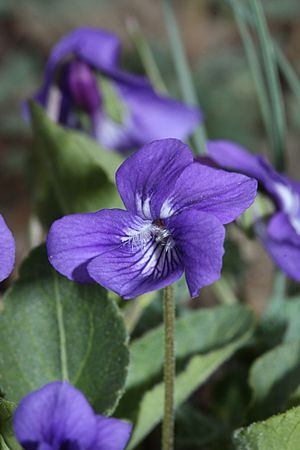Hookedspur violet facts for kids
Quick facts for kids Hookedspur violet |
|
|---|---|
 |
|
| Conservation status | |
| Scientific classification | |
| Genus: |
Viola (plant)
|
| Species: |
adunca
|
| Synonyms | |
|
Viola bellidifolia |
|
Viola adunca is a type of violet flower. It has many common names like hookedspur violet or early blue violet. You can find this plant growing in meadows and forests. It lives in western North America, Canada, and the northern United States.
This plant is usually hairy and grows in a compact way. It grows from a small underground stem system called a rhizome. Its leaves look like spades or hearts. They sometimes have wavy edges. These leaves are typically 1 to 4 centimeters long.
Each flower grows on a long, very thin stem called a peduncle. The flower hangs down and is violet in color. It has five purple petals. The three lower petals have white bases with purple lines. The two side petals have white hairs near the center. The two top petals might have small hooked parts at their tips. This plant lives for many years, making it a perennial.
There are a few different kinds of V. adunca. For example, a form with white petals has been seen in Yosemite National Park. This plant has also been found in Southern Ontario. There it grows in tall grass prairie areas and in black oak savannas.
Contents
Ecology and Life Cycle
Viola adunca is very important for some insects. It is the main food plant for the caterpillars of the Myrtle's silverspot butterfly. Bees and other insects help to pollinate the flowers. This means they help the plant make seeds.
The Polites mardon butterfly also drinks nectar from this plant. Birds and mice eat the seeds of Viola adunca. This shows how the plant is part of the food web in its habitat.
Conservation Status
In some parts of the United States, Viola adunca is rare. It is listed as an endangered species in Massachusetts and Connecticut. This means there are not many of these plants left in those states. Efforts are made to protect them.
Uses by Humans
The leaves and flowers of Viola adunca can be eaten. People can add them to salads or cook them like other greens. They can also be used to make tea. These parts of the plant are full of vitamins A and C.
However, it is important to know that not all parts of the plant are safe to eat. The underground stems (rhizomes), fruits, and seeds are not safe for humans. Eating them can cause an upset stomach or other problems.
Traditional Native American Uses
Native American tribes have used Viola adunca for many years. The Blackfoot people used a liquid made from the roots and leaves. They put it on sore or swollen joints. They also gave a liquid from the leaves and roots to children with asthma. The plant was also used to dye their arrows blue.
The Dakelh people drank a special tea made from the whole plant for stomach pain. The Klallam people would crush the flowers and put them on the chest or side for pain. The Makah people chewed the roots and leaves during childbirth. The Tolowa people put chewed leaves on sore eyes.
See also
 In Spanish: Viola adunca para niños
In Spanish: Viola adunca para niños



